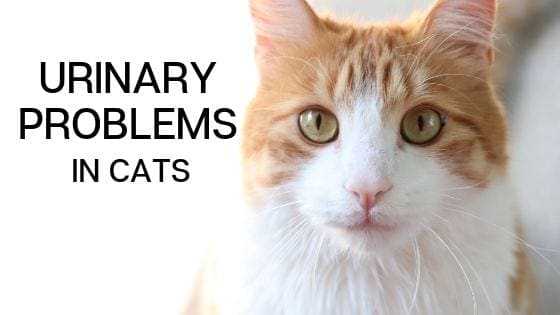
Urinary problems in cats — it’s something many cat parents had experienced. Whether it involves UTIs, urethral obstructions, environmental issues, stress, etc., if you live with cats long enough, you may have had to deal with it in some form or another. For some cats, a urinary problem is a one-time thing, but for others, urinary issues become recurring events. In the case of obstructions, emergency care is required because a cat can die very quickly. When a cat eliminates outside of the litter box, you can’t just ignore it, or place blame on the cat as being “bad”. More often than not, there’s a medical reason for the behavior.
Obstructions can occur because of the development of crystals that harden into stones (uroliths). The crystals can be made of magnesium ammonium phosphate (known as struvite) or they can be calcium oxalate. If crystals are detected in the urine by your veterinarian, a specific diet will be prescribed based on the type of crystals in order to alter the pH of the cat’s urine.
Even though litter box maintenance isn’t high on your list of fun things to do, it’s essential to monitor what is or isn’t happening in the box. Changes in how the urine looks, the amount, smell, frequency, or signs of blood are all red flags that something is wrong and your cat needs to be seen by the veterinarian. It’s also important to be observant of changes in your cat’s behavior, appetite, appearance, and weight.
Some Signs of Urinary Tract Problems
- Increased or decreased urination
- Excessive vocalization
- Vomiting
- Changes in weight
- Loss of appetite
- Distended abdomen
- Elimination outside of litter box
- Frequent trips to the litter box
- Crying or straining upon urination
- Blood in urine
- Change in urine color or odor
- Incontinence
- Inability to urinate (this is an emergency)
- Repeated licking of genital area
- Painful when touched in the abdominal area
- Restlessness
- Irritability
- Odor of ammonia on the cat’s breath
- Ability to only void small amounts of urine
The Role of Stress
A study was conducted in 2011 at the Ohio State University, led by Dr. Tony Buffington. The research revealed that when it comes to feline urinary issues, it was more than just being about the bladder. Urinary recurrences and stress were connected. Dr. Buffington coined the term for these urinary issues, Pandora Syndrome, after the Greek myth. The research connects the cat’s big enemy, stress, to frequent recurrences of Feline Idiopathic Cystitis. For more information on this disorder, refer to the following article:
Urethral Plugs
Male cats are at risk of urethral plugs. The soft, sandy material, which is made up of crystal fragments and mucous, builds up in the cat’s urethra. Because the male’s urethra is long and narrow, the risk of blockage is greater. If left untreated, this material will build up enough to actually form a plug that blocks the opening of the penis. If this happens, urine is unable to flow out. If the cat is unable to urinate this is an emergency. Male cats die very quickly if they don’t receive immediate emergency veterinary care.
In addition to not seeing any urine in the litter box, you may notice your cat repeatedly licking at his penis. If you feel his body you may detect a distended abdomen. Without emergency veterinary care, the cat will appear lethargic and become dehydrated. Don’t make the mistake of seeing your cat going back and forth to the litter box and just assume he’s constipated. Urethral plugs can cause death in a matter of hours.
Treatment for a urethral plug starts with first relieving the bladder. The veterinarian may insert a needle into the bladder to draw off the urine into a syringe. Sometimes a urethral plug can be removed with the cat under mild sedation. A catheter is then inserted into the penis to keep the urethra open and free of further obstruction. This is done temporarily. The cat will be given antibiotics and put on IV fluids.
If urethral plugs are an ongoing problem and prescription diet isn’t helping, then your veterinarian may recommend a surgery for your cat known as perineal urethrostomy. In this surgery, the narrow part of the urethra located at the penis is removed and a wider opening is created. In many cases though, keeping the cat on the appropriate prescription diet prevents the need for this last resort surgery.
Treatment for problems not involving blockages or crystals involves antibiotic therapy and in many cases, putting the cat on a therapeutic diet to maintain correct urine pH.
If there are crystals in the bladder then a catheter will be inserted (under sedation), IV fluids started and the bladder will be flushed out. The cat will be put on a course of antibiotics. When kitty is ready to go home you will be instructed as to whether to feed a prescription formula diet.
Specific prescription formula food is used for long-term treatment of cats with urinary tract issues. It’s important to keep the cat strictly on this diet and not supplement with other formulas for table food. You will also need to make sure there is a clean water supply available for your cat at all times. Monitor your cat’s water intake to ensure he’s drinking enough.
In addition to formula that you feed, the quantity is important as well. Don’t allow your cat to become obese. Incorporate exercise into his daily life through increased interactive playtime. And of course, keep stress to a minimum.
Helping to Prevent Urinary Problems
Food and water
Keep your cat on a high-quality diet. If prescribed a therapeutic diet by your veterinarian, keep your cat on it exclusively. If your cat isn’t given a prescription diet, talk to your veterinarian about which brand and type of food would be best. To keep water intake at optimal levels, your veterinarian may advise you to keep your cat on wet food and limit or eliminate dry kibble in the diet. Canned food is about 70% moisture and dry food has only about 10%. The cat on a diet of dry food exclusively will have to drink more water.
Make sure there is a fresh supply of water always available for your cat. If he doesn’t tend to drink much, consider adding a pet water fountain. The fountain circulates the water which helps keep it oxygenated so it tastes fresher. Additionally, the cat may enjoy playing with the water and then end up drinking more. Have water stations in multiple locations in the home. Don’t place water right next to food because many cats prefer there to be a distance between them.
Litter Boxes
Make sure you have enough litter boxes for the number of cats in the household and that they are easily accessible. Since stress contributes to urinary problems, don’t ask a cat to have to pass through an opponent cat’s area in order to get to the litter box. Make sure they’re located in areas where each kitty tends to hang out. There should be the same number of litter boxes as cats, plus at least one extra for good measure. There should be a box located in each cat’s preferred area. When a cat is using the litter box, it isn’t a time he should have to worry about being ambushed or attacked.
Keep the litter boxes scooped regularly and thoroughly scrub out the boxes and replaced with fresh litter often. Scooping should be done at least twice daily. Boxes should be thoroughly washed on a regular basis, depending on the type of litter used. If using scoopable litter, the box should be washed every 3-4 weeks. If using traditional clay litter, the box needs to be washed every 3-4 days.
Provide litter boxes that are the right size and shape for your cat. Don’t stress a cat out by insisting he go into a cramped covered box or try to squeeze into a box that’s really a better fit for a kitten. The box should be 1 1/2 times the length of the cat from tip of the nose to base of the tail.
Monitor your cat’s litter box habits. Become familiar with the normal size of his urine clumps each time you scoop. Changes in the size of the urine clumps may indicate a medical problem. If your cat begins eliminating outside of the box, that can be an indication of an underlying medical problem. Don’t assume it’s behavioral. Have your cat checked by the veterinarian whenever there’s a change in his normal habits.
Manage Stress
Stress is a known factor in contributing to the risk of urinary problems. Interstitial cystitis is commonly the result of stress in the cat’s life, as shown by the research conducted at the Ohio State University. What we view as not very stressful may be over-the-top on the stress-o-meter from a cat’s perspective. If there’s tension in your multicat home, a cat may be afraid to go to the litter box. As a result, he might start retaining urine as long as possible. If your cats aren’t getting along, begin behavior work to help them find a reason to like each other again. Reduction of cat conflict is crucial to minimizing stress. In some cases you may have to separate them and do a total reintroduction. In other cases, it may just involve giving them more activities and increasing environmental enrichment so they don’t just focus in on each other.
Look around your house and make sure all resources for the cats provide security. For example, make sure the mealtime environment doesn’t create intimidation and competition. It may mean you have to create more feeding stations in other rooms. In addition, look at where the cats like spending time to make sure everyone has safe and comfortable options for napping, scratching, climbing, and playing. It may mean you need to increase vertical territory, as well as providing more hiding places. And, as previously mentioned, ensure the litter box set-up is appealing.
Pay attention to other potential stressors in your environment that may be bothering your cat as well. Changes in the family, moving to a new home, renovation, schedule changes, and so on. Cats don’t like change so be aware of how something different or stressful in your household could impact the cat as well.
Increase the Fun Factor
When we think of exercise, we think of treadmills, gyms, working out, running or lifting weights. For the cat, exercise comes in the fun form of playtime. When your cat goes in play-mode, it’s a great way for the good brain chemicals to get released. It helps him develop positive associations with people, other animals and environments, and it keeps that athletic body of his in tip-top shape. Engage in daily interactive play sessions with your cat by using a fishing pole-type toy. Provide solo activities as well through the use of puzzle feeders and other interesting toys. Don’t just toss a fuzzy mouse in the center of room; hide it inside a paper bag or place it on the edge of the cat tree perch for kitty to find. Create a more interesting indoor environment.
Don’t Skip Veterinary Visits
In addition to being sure to take your cat to the veterinarian at the first sign of a problem, don’t overlook your cat’s routine veterinary care. This is the time when your veterinarian may detect something you weren’t aware of or you’ll be alerted to an increase or decrease in weight, change in blood test results, blood pressure, etc. Visit your veterinarian for routine vaccinations and exams on a yearly basis – more often if your cat is a senior kitty.
Need More Information?
If you have questions regarding your cat’s health, consult your veterinarian. For more specific information on how to create a more appealing litter box set-up, reduce stress in your cat’s environment or deal with litter box issues, refer to the best-selling books by Pam Johnson-Bennett. Pam’s books are available at bookstores everywhere and online. We’ve included Amazon links here on our website.
Note: This article is not intended as a medical diagnosis. If your cat is displaying a change in litter box habits, contact your veterinarian.


